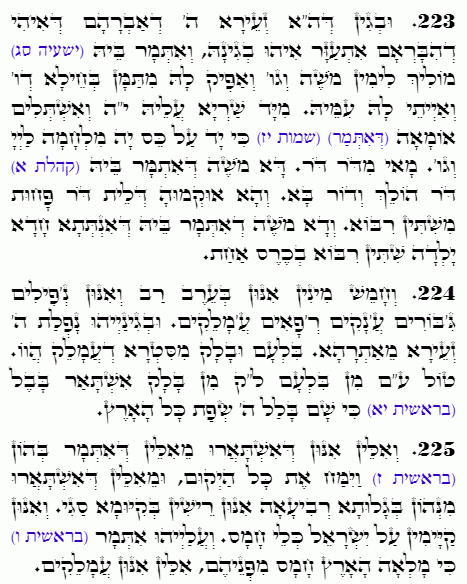Daily Zohar # 4687 – Beresheet – Nega Ra נגע רע
Daily Zohar 4687

Hebrew translation:
224. וַחֲמִשָּׁה מִינִים הֵם בְּעֵרֶב רַב, וְהֵם: נְ’פִילִים גִּ’בּוֹרִים עֲ’נָקִים רְ’פָאִים עֲ’מָלֵקִים. וּבִגְלָלָם נָפְלָה ה’ קְטַנָּה מִמְּקוֹמָהּ. בִּלְעָם וּבָלָק הָיוּ מִצַּד שֶׁל עֲמָלֵק. תִּקַּח ע”ם מִן בִּלְעָם, ל”ק מִן בָּלָק, יִשָּׁאֵר בָּבֶל, (בראשית יא) כִּי שָׁם בָּלַל ה’ שְׂפַת כָּל הָאָרֶץ.
225. וְאֵלֶּה אוֹתָם שֶׁנִּשְׁאֲרוּ מֵאוֹתָם שֶׁנֶּאֱמַר בָּהֶם (שם ז) וַיִּמַח אֶת כָּל הַיְקוּם. וּמֵאֵלֶּה שֶׁנִּשְׁאֲרוּ מֵהֶם בְּגָלוּת רְבִיעִית, הֵם רָאשִׁים בְּקִיּוּם רַב, וְהֵם מַעֲמִידִים עַל יִשְׂרָאֵל כְּלֵי חָמָס, וַעֲלֵיהֶם נֶאֱמַר (שם ו) כִּי מָלְאָה הָאָרֶץ חָמָס מִפְּנֵיהֶם. אֵלֶּה אוֹתָם עֲמָלֵקִים.
.
Zohar Beresheet
Continued from previous DZ
#223
The Torah shows the letter ה smaller in the word. Because of the small Hei—the Hei of Abraham, which is the Hei of (“when they were created”)—as mentioned above, Moses was aided by it. It is said about him, “מוֹלִיךְ לִימִין מֹשֶׁה” “He led Moses by the right hand with His glorious arm” (Isaiah 63:12). Moses extracted this Hei from the kelipot through the power of the Vav and brought it with him. By the Vav restoring the letters of the Holy Name to their place, along with the Nukva attached to them, Moses ascended and clothed the Yud of YHVH. He then elevated the Nukva with him and clothed it in the upper Hei of YHVH.
At that point, the Hei united with the Yud, being positioned above with the Vav. Then the oath stated in “כִּי יָד עַל כֵּס יָהּ מִלְחָמָה לַה’” “For the hand is on the throne of Yah” (Exodus 17:16) was fulfilled. Until that moment, the Name YHVH was incomplete because the Vav Hei were missing, and the throne was incomplete because the Aleph (of כסא Kiseh, “throne”) was missing. But now, the Name is complete with the Vav Hei, and the throne is complete with the Aleph.
The question is asked: What is the meaning of “ מִדֹּר דֹּר” Middor dor in the verse, “מלחמה לה’ בעמלק מדר דר” “YHVH will have war with Amalek from generation to generation” (Exodus 17:16)? The answer is: This refers to Moses, about whom it is said, “דּוֹר הֹלֵךְ וְדוֹר בָּא וְהָאָרֶץ לְעוֹלָם עֹמָדֶת.” “A generation goes, and a generation comes” (Ecclesiastes 1:4). The number sixty myriads (600,000) is associated with every generation, as it says that in Egypt, one woman gave birth to sixty myriads (600,000) in one womb, which refers to Moses.
#224
There are five types within the Erev Rav (Mixed Multitude): נפילים (Fallen Ones), גיבורים (Mighty Ones), ענקים (Giants), רפאים (Shades), and Amalekim. Because of them, the small Hei fell from its place, that is, from Binah. The explanation is that God made everything with its opposite “זֶה לְעֻמַּת זֶה עָשָׂה הָאֱלֹהִים” (Ecclesiastes 7:14), and just as there are five levels; Keter, Chokmah, Binah, Tiferet, and Malchut in holiness, there are corresponding five levels in the kelipot, which are the five types of the Erev Rav mentioned above. The initials of these five types form the acronyms נגע רע (Negah Ra, “bad affliction”) or ענג רע (Oneg Ra, “bad delight”) as listed later. For through evil, delight (ענג) turns into affliction (נגע), and affliction can turn into delight. These five types of the Erev Rav are mixed within Israel and cause them to sin. Because of this, the small Hei falls from its place, meaning it falls from the sweetening of Binah.
Balaam and Balak were from the aspect of עמלק Amalek. If you take the letters עם from בלעם Balaam and the letters לק from בלק Balak, you are left with the letters בב” ל (Babel/Babylon). This implies that the two kelipot, עמלק Amalek and בבל Babel, are hinted at in the names בלעם Balaam and בלק Balak. This teaches us that Amalek represents the head of the kelipot and their crown (Keter), just like the kelipah of Babel, about which it is said, “ראשה די דהב טב” “its head is of fine gold” (Daniel 2:32). For if they had not been from equal levels, they could not have unity as Balaam and Balak did.
#225
These are the ones who remained from those about whom it is said during the Flood: “וַיִּמַח אֶת כָּל הַיְקוּם אֲשֶׁר עַל פְּנֵי הָאֲדָמָה” “And He blotted out every living thing” (Genesis 7:23). They are what remains from the kelipa of Amalek in the fourth exile, which is the exile of Edom. These are the world leaders wielding great power because this kelipa represents the head and crown of the klipot, as mentioned earlier.
They become instruments of violence against Israel, and about them, it is said in the context of the Flood, “כִּי מָלְאָה הָאָרֶץ חָמָס מִפְּנֵיהֶם” “For the earth was filled with violence” (Genesis 6:13). These are the Amalekites. Thus, we have clarified the first of the five types of the Erev Rav, who are the עמלקים, Amalekites. They are the Keter of the kelipot.
Notes:
The Zohar identifies the Amalekites as a central and powerful force of opposition to Israel, stemming from the time of the Flood and persisting through Edom’s current exile. As the crown of the kelipot, the Amalekites represent the highest and most dangerous level of impurity, acting as instruments of violence and corruption. Their continued presence poses a significant spiritual and physical challenge to Israel, and they are seen as the first and most dangerous of the five types of the Erev Rav (נגע רע).
{||}

 Previous: Beresheet
Previous: Beresheet

